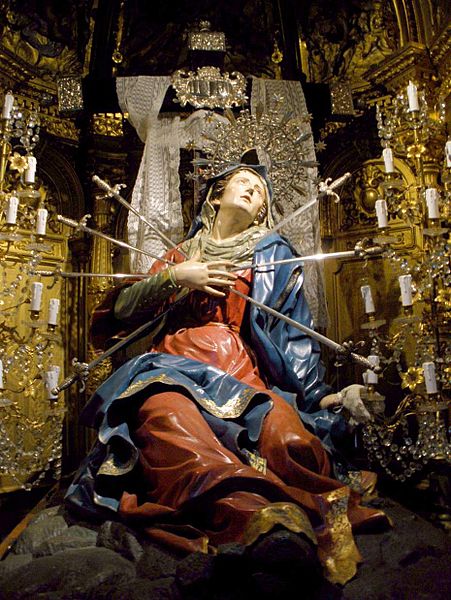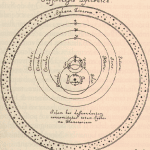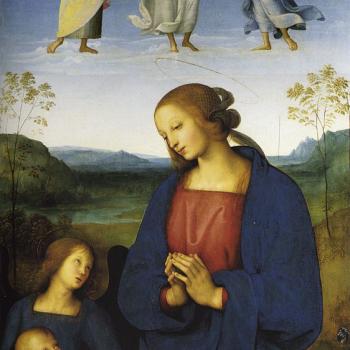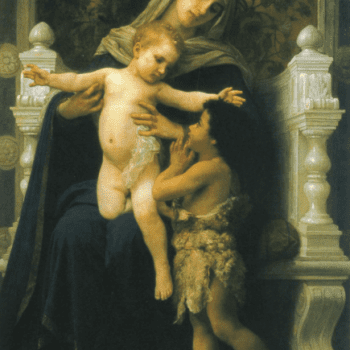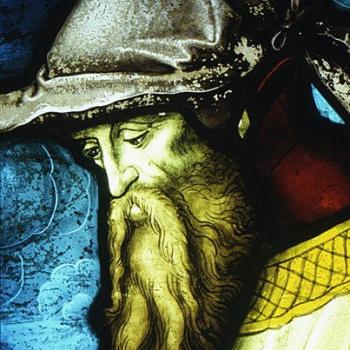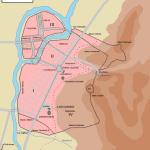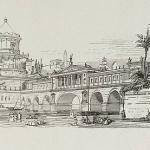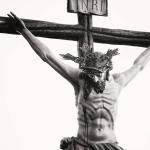Original title: “Was Pope Francis Guilty of Blasphemy and Mariological Heresy in His Comments on the Possible Momentary Temptation of Mary at the Cross?”
***
(1-19-14)
***
[Bible passages: RSV]
***
[this is Chapter Four from my book, Pope Francis Explained: Survey of Myths, Legends, and Catholic Defenses in Harmony with Tradition]
***
***
Pope Francis gave a homily at Mass on the morning of 20 December 2013 at Casa Santa Marta in Vatican City (Latin: Domus Sanctæ Marthæ; English: Saint Martha’s House). This is his own residence. It was devoted to the topic of silence before God, and acceptance of mystery, with regard, specifically, to the Blessed Virgin Mary.
News.Va: the “Official Vatican Network,” reported the pope’s words on the same day, via Vatican Radio (I’ll cite only the pope’s words in quotation marks in the article):
The Lord always took care of the mystery and hid the mystery. He did not publicize the mystery. A mystery that publicizes itself is not Christian; it is not the mystery of God: it is a fake mystery! And this is what happened to Our Lady, when she received her Son: the mystery of her virginal motherhood is hidden. It is hidden her whole life! And she knew it. This shadow of God in our lives helps us to discover our own mystery: the mystery of our encounter with the Lord, our mystery of our life’s journey with the Lord.
Each of us knows how mysteriously the Lord works in our hearts, in our souls. . . . This cloud in us, in our lives is called silence: the silence is exactly the cloud that covers the mystery of our relationship with the Lord, of our holiness and of our sins. This mystery that we cannot explain. But when there is no silence in our lives, the mystery is lost, it goes away. Guarding the mystery with silence! That is the cloud, that is the power of God for us, that is the strength of the Holy Spirit.
. . . how many times she [Mary] remained quiet and how many times she did not say that which she felt in order to guard the mystery of her relationship with her Son, . . .
The Gospel does not tell us anything: if she spoke a word or not… She was silent, but in her heart, how many things told the Lord! ‘You, that day, this and the other that we read, you had told me that he would be great, you had told me that you would have given him the throne of David, his forefather, that he would have reigned forever and now I see him there!’ Our Lady was human! And perhaps she even had the desire to say: ‘Lies! I was deceived!’ John Paul II would say this, speaking about Our Lady in that moment. But she, with her silence, hid the mystery that she did not understand and with this silence allowed for this mystery to grow and blossom in hope.
. . . Silence is that which guards the mystery . . . May the Lord give all of us the grace to love the silence, to seek him and to have a heart that is guarded by the cloud of silence.
Vatican Insider published basically the same, on the same day, and had a link at the bottom to the Italian original language. The second-to-last last paragraph in Italian is as follows:
Maria è stata la perfetta icona del silenzio. Dall’Annunciazione al Calvario. Papa Francesco pensa a “quante volte ha taciuto e quante volte non ha detto che quello che sentiva per custodire il mistero del rapporto con suo Figlio”, fino al silenzio del dolore muto “ai piedi della Croce. Il Vangelo non ci dice nulla: se ha detto una parola o no… Era silenziosa, ma dentro il suo cuore, quante cose diceva al Signore! ‘Tu, quel giorno – questo è quello che abbiamo letto – mi hai detto che sarà grande; tu mi hai detto che gli avresti dato il Trono di Davide, suo padre, che avrebbe regnato per sempre e adesso lo vedo lì!’. La Madonna era umana! E forse aveva la voglia di dire: ‘Bugie! Sono stata ingannata!’: Giovanni Paolo II diceva questo, parlando della Madonna in quel momento. Ma Lei, col silenzio, ha coperto il mistero che non capiva e con questo silenzio ha lasciato che questo mistero potesse crescere e fiorire nella speranza”.
Here’s the key phrase in Italian, with the Google translation:
La Madonna era umana! E forse aveva la voglia di dire: ‘Bugie! Sono stata ingannata!’
Our Lady was human! And perhaps [s]he had the urge to say: ‘Lies! I was deceived! ‘
I don’t understand why it has “he” instead of “she”: but that may lead into the almost inevitable translation questions, whenever these controversies arise. The rendering above translated “desire”: as does the Babylon online translator. The Zenit version has the word “urge” as well.
*
A person I discussed this with online, who speaks English, Spanish, Italian, and Latin, observed about the Italian word voglia (“desire” or “urge” above): that it’s “very nuanced and is best understood as something like ‘fleeting thought,’ ‘pang’ or ‘twinge.’ It implies an unbidden, sudden, spontaneous thought or temptation.”
Interestingly, the same homily, in excerpts on The Holy See / Vatican website (also on the News.va page, likewise derived from L’Osservatore Romano), does not contain the portion: “Our Lady was human! And perhaps she even had the desire to say: ‘Lies! I was deceived!’”
*
Both of these versions, however, contain the sentence, the opening clause of which is apparently, not a direct citation (my italics): “Likely, Mary would have thought back to the angel’s words regarding her Son: ‘On that day you told me he would be great! . . .’” This is important, because it makes it more clear that the pope was merely speculating. But he’s certainly doing that in any case, if he is pondering what Mary may have been thinking, since we have no recorded words from Scripture on that score. Be that as it may, I will assume that the reports of the most controversial language are accurate, and proceed accordingly in my analysis.
*
At first glance, I was myself troubled and confused by these remarks, in a way that I was not for any of the other “controversial” ones I have seen. Apologists don’t have all the “answers.” We have to learn and sometimes struggle trying to understand certain things, just like anyone else.
*
But the question is, whether any such struggle to learn and more accurately comprehend is within the outlook of a confident faith in God: that He guides the Catholic Church in a unique way, or under a paradigm of constant judging and criticizing of the pope when we may not understand something; and, frankly, seemingly a lack of faith and the obedient, “accepting” outlook that characterizes the devout, observant Catholic in matters that involve his or her Church.
The difference in the way I approached the “problem” compared to how the pope’s frequent detractors do, couldn’t be more striking. Here are my actual words, written on Facebook, the night before I studied the issue and arrived at the analysis below:
There’s only one papal statement that I’m aware of, that puzzles me, that I find difficult, but I am seeking to understand it by further inquiry, and believe I will be able to do so to my satisfaction. It’ll just take a little extra work, is all. Why should we expect that we would instantly understand everything a pope says, anyway? He’s supposed to stretch us and make us squirm a bit.*But it’s the underlying attitude of faith which is key: do we trust that God knows what He is doing through His vicar or not? Or will we question and doubt and criticize at every turn, which is the hallmark of the radical Catholic reactionary that I’ve been critiquing for 17 years online?*There are genuine questions within an overall attitude of faith and obedience, and there is willful dissent. I think those who exercise faith and diligence will come to understand most things if they seek and study and learn. So there is a time element, too. “Seek and ye shall find.” That takes time: sometimes a lot of time. We converts are very familiar with that process.*Confusion can exist for a variety of reasons. People are, for example, highly confused by many things in the Bible. Believe me, I know, as an apologist who deals with such questions all the time. No one has been more misunderstood than Jesus and Paul, yet that was God’s will that their words are in the Bible as is.*If I thought the pope couldn’t be defended I would say so and wouldn’t try to do it, but I think he can. I’m only confused by one remark and I’ll be studying further, myself, to better understand it.*The leading theologians of Jesus’ and Paul’s time were almost universally “concerned” about Jesus, too, and concluded that He was a compulsive liar, deceiver, and demon-possessed. Almost all of Pope St. Paul VI’s theological advisers told him not to write Humanae Vitae [the famous encyclical reiterating the prohibition of contraception]. He did, anyway. The bishops and theologians massively dissented from it after he wrote it. Sometimes popes can feel very much alone.*It’s one thing to say, “I don’t understand x that the pope said . . .” (I’m like that myself with regard to one statement that I’ve seen); quite another to issue highly judgmental, condemnatory blanket statements.*It took me 2-3 hours to “figure this out” to my own satisfaction, and I say anyone could have done so with minimal searching skills and a decent familiarity with Catholic theology and the Bible. But if I don’t understand something in theology (speaking generally), that’s not a crisis for me. I see that as the normal human condition (not everyone knows everything, nor should they expect to).*Why anyone would think they have to understand every jot and tittle of what the pope says is beyond me. Major issues: yes, that is normal to want to understand, but everything? And if we don’t it’s a personal and possibly an ecclesiological / spiritual crisis? No! That ultimately gets to issues of whether we have a simple faith and trust in God, Who guides His Church, or not.
That was my attitude, “going in.” Now (before I go on to provide my analysis), contrast that with the rabid attacks on the pope that have occurred in relation to this homily.
A radical Catholic reactionary blog called The Eponymous Flower (self-described as “polemical Catholic Royalist”) had a field day with this, writing on 22 December 2013:
[T]he Pope expressed hitherto completely new thoughts on the attitude of Mary on Calvary this past Friday. Is Pope Francis forming Marian theology? Mary not as co-redeemer, but as a rebel? . . . Maria Accused God of Deceit? . . . upon which theological arguments does Pope Francis base his pronouncing a very, let us say with the utmost restraint, “impetuous” judgment of the Blessed All Holy Virgin Mary? We sincerely have no idea. If they were really spoken or thought by the Mother of God, they would be called blasphemous. But the doubts and the questions that Pope Francis puts in Mary’s mouth, have no equivalent in Revelation, even less in the tradition of the Church or in the Fathers.
The same person also wrote in comments:
The troubling part here is the appearance of the usual Modernist technique of infiltrating doubt, discord and confusion about articles of Faith where the “Church has been silent.” . . . Mistakes are not the same thing as obvious doctrinal errors, or scandalous comments made in public by a Pope. Surely, his public witness has not only been unprecedented, but very worrying to those few who are still Catholic.
With “friends” like this in the Church, who needs enemies? The devil must be laughing his fool head off.
Catholic blogger Elliot Bougis, who has written some great stuff in the past, has apparently lately been entranced by the same sort of worthless radical Catholic reactionary rhetoric and polemics, and now deigns to lecture the Holy Father and those doltish enough to actually extend to him respect and the benefit of the doubt, as if all alike were errant, snot-nosed children. He pontificated on his site, FideCogitActio: “Omnis per gratiam”:
The central issue is simply that it is a deviation from Catholic tradition to say that, in the act of having such difficulties, Our Lady would accuse, or even “semi-accuse,” God of deceit (or betrayal). . . . I (and numerous other concerned Catholics) would not be prone to such “swipes” (merely to borrow my critic’s term), if Pope Francis did not take so many swipes at the faithful and the Faith itself.*A larger issue is that the pope’s gaffe on this point is not anything new. He has proven himself to be a frequently unreliable expositor of the Faith. Too many nuances fudged, too many half-truths valorized, too little clarification in the face of too much confusion. While I am certainly not saying that everything he says is wrong–quite to the contrary, it is the ragged litany of sporadic malapapalisms which detract from his otherwise conventional orthodoxy–, I am saying that his consistent tendency to confuse and shock the faithful renders him unreliable as a catechist.*. . . As it stands, though, it only reinforces the pattern that we must admit: Pope Francis is not a careful thinker and he is often extremely incautious with his words. Any pastor who requires the help of legions of defenders to show how his malapapalisms “mesh” with the Faith, is simply a poor teacher, and it’s not mockery to call a spade a spade.
John Vennari, writing for the radical Catholic reactionary site Catholic Family News, makes similar grand, quasi-conspiratorial claims:
Pope Francis is certainly a newsmaker, as he continually utters confusing statements that leave Catholics reeling the world over. The above statement about Our Lady is certainly one of the most troublesome.*Pope Francis, by claiming Our Lady was probably surprised and confused by the drama of the Crucifixion, actually promotes a Protestant reading of the Blessed Mother that emphasizes her “humanity” over the unique exalted gifts she received as Mother of God. Whether he realized it or not, Pope Francis’ statements are actually a denigration of Our Lady, and the first who would say so is Saint Alphonsus Ligouri.
Ironically (and, I think, quite humorously), while Vennari (like Bougis) accuses the Holy Father of forsaking genuine Catholic Mariological tradition, he differs with Bougis on whether Pope St. John Paul II (in his “New Way of the Cross” from 2001: to be cited below) is likewise guilty, and states: “Saddest of all, Pope Francis hearkens back to Pope St. John Paul II as the basis of his meditation. In this Francis is accurate.”
*
Bougis, on the other hand, classes John Paul the Great with “the good [orthodox] guys”:
The subtle but crucial difference between what Pope Francis insinuates and what John Paul II teaches, sheds further light on why countless healthy Catholic souls have reacted so negatively to Pope Francis’s latest bungling of the Tradition. . . . This is subtly but crucially different from what Pope Francis has, wittingly or not, foisted upon us as children of the Mystical Rose. John Paul II’s orthodoxy becomes even clearer when read in connection with his more formal statements in Redemptoris Mater §18:
To top it off, the article from The Eponymous Flower, cited above, stakes out a third position; namely, that Pope John Paul II was correct in his Mariology, but (differing from both Bougis and Vennari) that Pope Francis was inaccurately (or wrongheadedly) drawing from a completely different document (!):
The daring interpretation that Pope Francis gives to Mary’s silence, gives rise spontaneously to two questions. The first question that imposes itself is: In what document or speech is Pope John Paul II to have put such words of the Virgin Mother of God in her mouth?Some searching and consultation of a colleague proved successful. The passage refers to the Encyclical Redemptoris Mater . . .
Thus we observe the comedic spectacle of three writers trashing the Holy Father, yet contradicting each other, as to the relation of the supposed dreadful comments to the teaching of Pope St. John Paul II (and from which document of his). It rather reminds one of the witnesses against Christ contradicting each other (Mark 14:56). But it does provide much-needed entertainment in an otherwise dreary, boorish affair (where one has to “laugh to keep from crying”).
*
Now, let’s move on to examine some biblical analogies and relevant passages, look at a few examples of the same sort of notions in previous Catholic Mariology, and finally, to consult in some depth, many other Marian utterances of Pope Francis. I submit that this will allow a very different picture to emerge. The first thing to note is that Mary didn’t have comprehensive knowledge of all the particulars of Jesus’ ministry and mission. The most well-known example was when Jesus was teaching in the temple at age twelve:
Luke 2:48-50 And when they saw him they were astonished; and his mother said to him, “Son, why have you treated us so? Behold, your father and I have been looking for you anxiously.” [49] And he said to them, “How is it that you sought me? Did you not know that I must be in my Father’s house?” [50] And they did not understand the saying which he spoke to them.
This conclusively shows that she didn’t have exhaustive knowledge. She didn’t even understand after Jesus explained. It doesn’t follow that she didn’t know that He was God incarnate ad the Messiah; only that she didn’t know everything there was to know about Him: all particulars and fine points.
The next thing to determine is whether Mary could be tempted (even fleetingly) with untrue thoughts or despairing emotions. Yes, of course! God Himself can be tempted; that is, the devil and men can attempt to do so. They will be – can only be – unsuccessful, but they can try:
Sirach 18:23 Before making a vow, prepare yourself; and do not be like a man who tempts the Lord.
Acts 5:9 But Peter said to her, “How is it that you have agreed together to tempt the Spirit of the Lord? . . .” [the Holy Spirit is God; cf. 5:3-4]
Hebrews 4:15 For we have not a high priest who is unable to sympathize with our weaknesses, but one who in every respect has been tempted as we are, yet without sin.
Jesus was, of course, tempted by the devil for 40 days in the wilderness:
Luke 4:1-2, 12-13 And Jesus, full of the Holy Spirit, returned from the Jordan, and was led by the Spirit [2] for forty days in the wilderness, tempted by the devil. . . . [12] And Jesus answered him, “It is said, ‘You shall not tempt the Lord your God.’” [13] And when the devil had ended every temptation, he departed from him until an opportune time.
Therefore, since God Himself can be tempted (unsuccessfully), so can Mary, who is His creature, as the lesser of the two (and also unsuccessfully, but the devil can try). A sudden temptation entering Mary’s mind, as a human being, watching her Son being tortured to death on the cross, is both quite understandable and contrary to nothing in Catholic theology. She could be tempted, just as Jesus was, but did she give into it?, is the question. The pope reiterated here and elsewhere that she did not do so.
But the thought is altogether possible, especially when we note what the Italian voglia means. If my friend was correct, it is a “fleeting thought” or mere “pang” or “twinge”; “an unbidden, sudden, spontaneous thought or temptation.” This was what the pope was saying. It may have / could possibly have / understandably would have (mere speculation) entered her head. If so, she didn’t act upon it, and it didn’t annihilate her steadfast faith.
The next related thing is to ponder analogies to her Divine Son. Could He: 1) tremendously suffer; all the while not ever wavering in resolve, and 2) feel forsaken or profoundly separated from His Father, in His human nature even though He never was separated from Him for even an instant in His Divine Nature? Yes, on both counts. Again, then, the analogical reasoning is: “as the greater [God] is, so the lesser [creature] plausibly is all the more so.”
The most obvious example of this is Jesus’ words from the cross: “My God, my God, why hast thou forsaken me?” (Matthew 27:46). The Church father, St. Hilary of Poitiers attributed this to “weakness” in Jesus human nature:
Christ, who had depended in all things upon His Father’s support, now deserted and left to death, mourns over this desertion, and pleads with Him departing. . . . The complaint of His being deserted is the weakness of the dying man; the promise of Paradise is the kingdom of the living God. You have Him complaining that He is left to death, and thus He is Man; you have Him as He is dying declaring that He reigns in Paradise; and thus He is God. Wonder not then at the humility of these words, when you know the form of a servant, and see the offence of the cross.3
The great Jesuit commentator and exegete, Cornelius a Lapide (1567-1637), adds:
Christ therefore does not cry out as being forsaken by the Godhead and hypostatic union of the Word, nor even by the grace and love of God, but only because the Father did not rescue Him from instant death, nor soothe in any way His cruel sufferings, but permitted Him to endure unmitigated tortures. And all this was to show how bitter was His death on the Cross, the rending asunder of His soul and body with such intense pain as to lead Him to pray in His agony and bloody sweat, “Father, if it be possible,” &c.; So St. Jerome, St. Chrysostom, Theophylact, and other Fathers; nor do & Hilary and St. Ambrose mean anything else in saying, “The man cried aloud when dying at being separated from the Godhead.” For they mean not a severing of essence and of the hypostatical union, but of support and consolation. For the faith teaches us that though the soul of Christ was separated from His body, yet the Godhead remained as before, hypostatically united both to His soul and His body.4
The agony of our Lord Jesus in the Garden of Gethsemane is another similar instance of this intense suffering:
Matthew 26:36-44 Then Jesus went with them to a place called Gethsem’ane, and he said to his disciples, “Sit here, while I go yonder and pray.” [37] And taking with him Peter and the two sons of Zeb’edee, he began to be sorrowful and troubled. [38] Then he said to them, “My soul is very sorrowful, even to death; remain here, and watch with me.” [39] And going a little farther he fell on his face and prayed, “My Father, if it be possible, let this cup pass from me; nevertheless, not as I will, but as thou wilt.” [40] And he came to the disciples and found them sleeping; and he said to Peter, “So, could you not watch with me one hour? [41] Watch and pray that you may not enter into temptation; the spirit indeed is willing, but the flesh is weak.” [42] Again, for the second time, he went away and prayed, “My Father, if this cannot pass unless I drink it, thy will be done.” [43] And again he came and found them sleeping, for their eyes were heavy. [44] So, leaving them again, he went away and prayed for the third time, saying the same words.
So Jesus could pray, not once, but three times, that if it were possible, He could avoid the cross, yet we are to believe that Mary, a mere creature, cannot even for a fleeting instant while watching her Son die an excruciatingly painful death on the cross have any thought or temptation whatsoever that this seemed to be contrary to the glorious “messianic kingdom” proclamations by the angel at the Annunciation? She’s not supposed to feel anything: any agony: even without accompanying doubt or sin? That makes no sense.
If that is impossible or unthinkable for her to do, certainly these analogous “agonizing” thoughts from Jesus would not have occurred, either. But they did; thus we conclude by analogy that Mary may have had similar thoughts. In Jesus, there was the striking contrast between His being God (Who cannot suffer), and man (who can and does suffer). In Mary (if indeed she thought this), the contrast was between the triumphant messianic kingdom and the “suffering servant” Messiah of Isaiah 53.
Lapide writes in his commentary on Matthew 26:37:
The primary cause of His sorrow was not the flight of His Apostles, which He foresaw, but the vivid apprehension of His approaching Passion and death, as is plain from His prayer, “Let this cup pass from Me.” For Christ foresaw all the torments, one by one, which the Jews would inflict on Him, and fully entered into and weighed the magnitude and bitterness of His several sorrows, so as to seem to be already suffering them, even to the shedding of His blood. For Christ doubtless wished to atone by His sorrow for the pleasure which Adam had in eating the forbidden fruit, and which sinners now experience in their sins. . . . the sorrows of the Son pierced, as a sword, the soul of the mother, and from her were reflected on Christ. For His greatest sorrow was that His mother suffered so grievously on His account.
St. Augustine exegeted Matthew 26:39 as follows:
Christ thus as man shows a certain private human will, in which He who is our head figures both His own will and ours when He says, “Let it pass from me.” For this was His human will choosing something as apart for Himself. But because as man He would be righteous and guide Himself by God’s will, He adds, “Nevertheless not as I will, but as thou wilt;” as much as to say to us, Man, behold thyself in Me, that thou canst will somewhat apart of thyself, and though God’s will is other, this is permitted to human frailty.5
On the same passage, Lapide comments (note the close analogy to Pope Francis’ speculation about Mary):
My Father, if it be possible, let this cup pass from Me. Absolutely this was possible, but it was impossible according to God’s decree that man was to be redeemed by Christ’s death. Christ knew this, and therefore did not wish for it absolutely, and asks for nothing contrary to His own and the Father’s will. But He merely expresses His natural shrinking from death, His ineffectual and conditionated [sic] will, and yet freely submitted Himself to the contrary will of God, that He should die.
. . . the natural will of Christ was conditional and of no avail, because it wished to escape death only under the condition that it pleased God. But His rational will was absolute and effectual, because He embraced death for the same reason that God willed it, that is, for man’s redemption. But the natural will of Christ seemed materially contrary to the Divine will. But by the rule of subordination it was conformable to it, as suffering itself to be guided by the rational will, and thus by the Divine will; and, on the other hand, the will of God, as well as the rational will of Christ, wishes on deliberate and just ground that His natural will should express this natural fear of death. In both aspects, therefore, was the will of Christ in all respects conformable to the Divine.
Jesus showed very human emotion at other times, as well, such as weeping over Lazarus’ death, even though He was to raise him shortly afterward:
John 11:32-35, 38 Then Mary, when she came where Jesus was and saw him, fell at his feet, saying to him, “Lord, if you had been here, my brother would not have died.” [33] When Jesus saw her weeping, and the Jews who came with her also weeping, he was deeply moved in spirit and troubled; [34] and he said, “Where have you laid him?” They said to him, “Lord, come and see.” [35] Jesus wept. . . . [38] Then Jesus, deeply moved again, . . .
The following lamentation from Jesus was obviously quite emotional:
Matthew 23:37 O Jerusalem, Jerusalem, killing the prophets and stoning those who are sent to you! How often would I have gathered your children together as a hen gathers her brood under her wings, and you would not!
Another instance of human discomfort with a simultaneous full resolve to follow God’s will wherever it leads, is St. Paul’s thorn in the flesh:
2 Corinthians 12:7-10 And to keep me from being too elated by the abundance of revelations, a thorn was given me in the flesh, a messenger of Satan, to harass me, to keep me from being too elated. [8] Three times I besought the Lord about this, that it should leave me; [9] but he said to me, “My grace is sufficient for you, for my power is made perfect in weakness.” I will all the more gladly boast of my weaknesses, that the power of Christ may rest upon me. [10] For the sake of Christ, then, I am content with weaknesses, insults, hardships, persecutions, and calamities; for when I am weak, then I am strong.
The anguished cry and feeling of “how long?” has a longstanding history from the Old Testament: at least as far back as King David. Mary could have been thinking of the messianic expectation (which was highlighted at the Annunciation (see Lk 1:31-33), crushed (in a sense) at the prospect of Jesus having to die a horrible death without the kingdom coming in physical terms, with judgment of sinners:
Psalm 6:2-7 Be gracious to me, O LORD, for I am languishing; O LORD, heal me, for my bones are troubled. [3] My soul also is sorely troubled. But thou, O LORD — how long? [4] Turn, O LORD, save my life; deliver me for the sake of thy steadfast love. [5] For in death there is no remembrance of thee; in Sheol who can give thee praise? [6] I am weary with my moaning; every night I flood my bed with tears; I drench my couch with my weeping. [7] My eye wastes away because of grief, it grows weak because of all my foes. (cf. 13:1-2; 35:17)
Psalm 74:10 How long, O God, is the foe to scoff? Is the enemy to revile thy name for ever? (cf. 90:13; 94:3; 119:84; Hab 1:2)
Lamentations 5:20-22 Why dost thou forget us for ever, why dost thou so long forsake us? [21] Restore us to thyself, O LORD, that we may be restored! Renew our days as of old! [22] Or hast thou utterly rejected us? Art thou exceedingly angry with us?
Such prayers are even made by the angel of the Lord (Zech 1:12), and redeemed souls in heaven (Rev 6:10).
As the pope noted, Mary was a human being! Is she not allowed even a micro-second of agony and sadness and sorrow? Does not human emotion have a “logic” of its own, that often runs contrary to what our minds and wills would “say”? Is it not possible for her to be tempted, just as Jesus was? Do we believe that she was so “super-human” that she could never have any “depression” at all about anything: up to and including the cruel death of her Son on the cross?
*
Is she absolutely different from the prophet Elijah? He had just triumphantly confronted the false prophets of Baal on Mt. Carmel (1 Kings 18). But in the very next chapter, we see him struggling mightily, as a weak human being. He’s described as “afraid” (19:3), wanting to “die” (19:4), worrying about being killed (19:14). He agonized with doubt; Mary and Christ did so without the doubt that would suggest lack of faith or sin.
*
Now, contrary to “assured” and loudmouthed proclamations that the pope expressed something completely new, novel, and heterodox, we see almost the same notion in Pope St. John Paul II’s New Way of the Cross / Via Crucis 2000; fourth station:
“Do not be afraid, Mary, for you have found favour with God. And behold, you will conceive in your womb and bear a son, and you shall call his name Jesus. He will be great, and will be called the Son of the Most High; and the Lord God will give to him the throne of his father David, and he will reign over the house of Jacob for ever; and his kingdom will have no end” (Lk 1:30-33).*Mary remembered these words. She often returned to them in the secret of her heart. When she met her Son on the way of the Cross, perhaps these very words came to her mind. With particular force. “He will reign . . . His kingdom will have no end”, the heavenly messenger had said.*Now, as she watches her Son, condemned to death, carrying the Cross on which he must die, she might ask herself, all too humanly: So how can these words be fulfilled? In what way will he reign over the House of David? And how can it be that his kingdom will have no end?*Humanly speaking, these are reasonable questions.*But Mary remembered that, when she first heard the Angel’s message, she had replied: “Behold, I am the handmaid of the Lord. May it be done to me according to your word” (Lk 1:38).*Now she sees that her word is being fulfilled as the word of the Cross. Because she is a mother, Mary suffers deeply. But she answers now as she had answered then, at the Annunciation: “May it be done to me according to your word”.*In this way, as a mother would, she embraces the cross together with the divine Condemned One.*On the way of the Cross Mary shows herself to be the Mother of the Redeemer of the world.*“All you who pass by the way, look and see whether there is any suffering like my suffering, which has been dealt me” (Lam 1:12).*It is the Sorrowful Mother who speaks, the Handmaid who is obedient to the last, the Mother of the Redeemer of the world.*PRAYER*O Mary, who walked the way of the Cross with your Son, your mother’s heart torn by grief, but mindful always of your fiat and fully confident that He to whom nothing is impossible would be able to fulfil his promises, implore for us and for the generations yet to come the grace of surrender to God’s love.6
It’s all there. There is nothing here that isn’t present in Pope Francis’ thoughts. Here is the controversial section of his homily again:
She was silent, but in her heart, how many things told the Lord! ‘You, that day, this and the other that we read, you had told me that he would be great, you had told me that you would have given him the throne of David, his forefather, that he would have reigned forever and now I see him there!’ Our Lady was human! And perhaps she even had the desire to say: ‘Lies! I was deceived!’ John Paul II would say this, speaking about Our Lady in that moment.
And now a point-by-point comparison:
Pope St. John Paul II referred to Mary pondering the “messianic kingdom” words of the Annunciation, at the cross. So did Pope Francis. Both cited the words or content of the angel’s message at the Annunciation. John Paul II uses the words “all too humanly,” and “humanly speaking.” Pope Francis declares, “Our Lady was human!” Pope St. John Paul II “wonders out loud”:
[S]he might ask herself, all too humanly: So how can these words be fulfilled? In what way will he reign over the House of David? And how can it be that his kingdom will have no end?
Pope Francis merely puts John Paul II’s words, “how can,” “In what way,” “how can it be” in more graphic, human, hyper-emotional terms, of the sort that the devil might momentarily put into a mind, even the mind of a holy, sinless person like the Blessed Virgin Mary (which she then instantly rejects upon reflection):
And perhaps she even had the desire to say: ‘Lies! I was deceived!’
Both popes portray Mary as overcoming these highly emotional thoughts with a profound, unwavering faith. Francis references the earlier reflections of his papal predecessor and right after that, concludes, similarly: “But she, with her silence, hid the mystery that she did not understand and with this silence allowed for this mystery to grow and blossom in hope.” It ends in hope and trust and faith, not despair and “blasphemy.”
She (possibly) had a fleeting thought and temptation. It didn’t succeed in rocking or displacing her solid faith. The pope’s detractors think they have proven something by emphasizing the one pungent phrase, minus context, and any comparative analysis of the pope’s overall teaching on Mary (which is what I’ll do next), or much thought at all of the scriptural backdrop.
*
An elementary rule in interpreting anything is to do it within the overall body of a person’s thought. In biblical exegesis and systematic theology, one finds massive cross-referencing, and also the time-honored notion that more obscure biblical passages are to be interpreted by clearer ones along the same lines. As far as I can tell, the pope’s scathing critics in this regard have not done that at all, whereas I have pored over as many of his utterances elsewhere about Mary as I could find. Do these clarify his thinking? They sure do, and quite dramatically and definitively so.
*
In an hour or so of searching online, I found a goldmine of Marian teaching from Pope Francis. One was from less than a month before the homily in question, on exactly the same subject matter (thus allowing us to have more insight about what he meant):
Our Lady looks at her Son’s mission with exultation but also with apprehension, because Jesus becomes increasingly the sign of contradiction that the elderly Simeon had pre-announced to her. At the foot of the cross, she is the woman of sorrow and at the same time of vigilant waiting of a mystery, greater than the sorrow, which is about to take place. Everything seems truly finished; every hope it could be said was spent. At that moment, recalling the promises of the Annunciation, she also could have said: they have not come true, I was deceived. But she did not say it.Yet she, blessed because she believed, sees blossom from her faith the new future and waits with hope for God’s tomorrow.7
Note that in this form, her momentary temptation or doubt reads more in terms of her possibly having been mistaken. It’s an emotion we’re all familiar with: we’re disappointed, crushed, highly upset about something, and we conclude that we have been wrong about something, where previously we felt quite certain. This goes back to Mary not having all particular knowledge of God’s salvation plan.
To say, “I was deceived” is vastly different from saying, “God deceived me.” But that was the same language Pope Francis used in the later homily, so the same reasoning would apply there as well. It’s not necessarily blaming God; blaspheming by thinking He is a “liar.” But that is how many have interpreted it, with a complete lack of charity as well as reason.
Instead of the highly charged word, “lies” we have the milder “they have not come true.” Both of these choices of words lead us to interpret the later utterance much less “radically” than the rabid critics and self-important “orthodoxy cops” do.
The earlier statement has “could have said” followed quickly by the denial: “did not say it.” The later homily also ends in hope and affirmation: “she, with her silence, hid the mystery that she did not understand and with this silence allowed for this mystery to grow and blossom in hope.” The ending of the earlier meditation (immediately after the citation above) is all about a bright, sunny hope (Mary’s hope in that dark hour is something that she also comforts us with, as the exemplar of hope and faith):
Sometimes I wonder: are we able to wait for God’s tomorrow? Or do we want it today? For her God’s tomorrow is the dawn of the Easter morning, of that first day of the week. It would do us good to contemplate the Son’s embrace with the Mother. The only lighted lamp at the entrance of Jesus’ sepulcher is his Mother’s hope, which at that moment is the hope of the whole of humanity. I ask myself and you: is this lamp still alight in convents? Is God’s tomorrow still awaited in convents?
We owe much to this Mother! In her, present in every moment of the history of salvation, we see a solid witness of hope. She, Mother of hope, supports us in moments of darkness, of difficulty, of distress, of apparent defeat or of real human defeats. May Mary, our hope, help us to make of our life a pleasing offering to the Heavenly Father, and a joyful gift for our brothers, an attitude that always looks to tomorrow.
Another hostile assumption employed by the papal detractors is an insinuation that, somehow, Pope Francis has denied the traditional doctrine of Mary as Co-Redemptrix, or (the more common term) Mediatrix. It seems to be thought that he has a low or undeveloped or heretical Mariology, when in fact, he holds to this tenet, which is disputed (wrongly) even among some orthodox Catholics.
If in fact, he agrees that Mary participated in the redemption by offering her Son, by her consent, this is hardly commensurate with some silly idea that she was doubting the whole time. He does agree. Here is the proof:
Mary is model of union with Christ. The life of the Holy Virgin was the life of a woman of her people: she prayed, worked, went to the synagogue … However, every action was always carried out in perfect union with Jesus. This union reached its climax on Calvary: here Mary unites herself to her Son in the martyrdom of the heart and in the offering of life to the Father for the salvation of humanity. Our Lady made her own the pain of her Son and with Him accepted the Father’s will, in that obedience that bears fruit, which gives the true victory over evil and death.
This reality that Mary teaches us is very beautiful: to be always united to Jesus. We can ask ourselves: do we remember Jesus only when something is not going well or when we are in need, or is our relationship constant, a profound friendship, also when it is a question of following him on the way of the cross?9
The rest of the same teaching, before and after the above citation, follows:
How did Mary live this faith? In the simplicity of the thousands of daily occupations and preoccupations of every mother, such as providing food, clothes, the care of the home … In fact this normal existence of Our Lady was the terrain where a singular relationship took place and a profound dialogue between her and God, between her and her Son. Mary’s “yes,” already perfect at the beginning, grew up to the hour of the Cross. There her maternity was dilated embracing each one of us, our life, to lead us to her Son. Mary always lived immersed in the mystery of God made man, as his first and perfect disciple, meditating everything in her heart in the light of the Holy Spirit, to understand and put into practice the whole will of God. . . .*Let us ask the Lord to give us the gift of his grace, his strength, so that in our life and in the life of every ecclesial community the model is reflected of Mary, Mother of the Church. So be it!
Pope Francis teaches that Mary said “yes” at the cross as well as at the Annunciation:
Mary said her yes to God: a yes which upset her simple life in Nazareth, and not only once. Any number of times she had to utter a heartfelt yes at moments of joy and sorrow, culminating in the yes she spoke at the foot of the Cross. Here today there are many mothers present; think of the full extent of Mary’s faithfulness to God: seeing her only Son on the cross. . . .
The Church and Pope Francis also hold that Mary’s faith was a “journey”; it wasn’t whole and entire from the beginning of her calling:
The third aspect is Mary’s faith as a journey. The Council says that Mary “advanced in her pilgrimage of faith” (Lumen Gentium, 58). In this way she precedes us on this pilgrimage, she accompanies and sustains us.
How was Mary’s faith a journey? In the sense that her entire life was to follow her Son: he – Jesus – is the way, he is the path! To press forward in faith, to advance in the spiritual pilgrimage which is faith, is nothing other than to follow Jesus; . . . The way of Jesus is the way of a love which is faithful to the end, even unto sacrificing one’s life; it is the way of the cross. The journey of faith thus passes through the cross. Mary understood this from the beginning, when Herod sought to kill the newborn Jesus. But then this experience of the cross became deeper when Jesus was rejected. Mary was always with Jesus, she followed Jesus in the midst of the crowds and she heard all the gossip and the nastiness of those who opposed the Lord. And she carried this cross! Mary’s faith encountered misunderstanding and contempt. When Jesus’ “hour” came, the hour of his passion, . . . Mary’s faith was a little flame burning in the night, a little light flickering in the darkness. Through the night of Holy Saturday, Mary kept watch. Her flame, small but bright, remained burning until the dawn of the resurrection. And when she received word that the tomb was empty, her heart was filled with the joy of faith: Christian faith in the death and resurrection of Jesus Christ. Faith always brings us to joy, and Mary is the Mother of joy! . . . What is our faith like? Like Mary, do we keep it burning even at times of difficulty, in moments of darkness? Do I feel the joy of faith? This evening, Mother, we thank you for our faith, the faith of a strong and humble woman; we renew our entrustment to you, Mother of our faith. Amen.11
Moreover, the Holy Father teaches that Mary never lost hope during Christ’s passion:
Hope – he said – is what Mary, Mother of God, sheltered in her heart during the darkest time of her life: from Friday afternoon until Sunday morning. That is hope: she had it. And that hope has renewed everything. 12
Her faith never wavered, even at the time of her darkest, most painful trial:
. . . Standing at the foot of the cross with unyielding faith, you received the joyful comfort of the resurrection, and joined the disciples in awaiting the Spirit so that the evangelizing Church might be born.
Nor did her strength falter at the cross:
She bore in her heart, throughout the pilgrimage of her life, the words of the elderly Simeon who foretold that a sword would pierce her soul, and with persevering strength she stood at the foot of the cross of Jesus. She knows the way, and for this reason she is the Mother of all of the sick and suffering. To her we can turn with confidence and filial devotion, certain that she will help us, support us and not abandon us. She is the Mother of the crucified and risen Christ: she stands beside our crosses and she accompanies us on the journey towards the resurrection and the fullness of life.
Footnotes
1. “A follow-up on Our Lady of Doubts…” (24 December 2013).
2. “Pope Francis’ Protestant Meditation on Our Lady” (22 December 2013).
3. De Trin., 10:50 &c.; cited in St. Thomas Aquinas’ Catena Aurea: Commentary on the Four Gospels, Collected Out of the Works of the Fathers.
4. Commentary on Matthew (27:46).
5. In Ps. 32, Enar. 2; cited in St. Thomas Aquinas’ Catena Aurea: Commentary on the Four Gospels, Collected Out of the Works of the Fathers.
6. The Holy See / Vatican website; “Liturgical Year: Holy Week 2004.”
7. Meditation at the Convent of Saint Anthony Abbot, Vatican City, 22 November 2013; from Zenit.org. Italics for emphasis are my own.
8. Ibid.
9. “On Mary, Model of Faith, Charity and Union with Christ”; catechesis at his general audience, St. Peter’s Square, 23 October 2013; from Zenit.org; italics my own.
10. Homily at Mass for Marian Day, Vatican City, 14 October 2013; from Zenit.org.
11. Catechesis at Marian Day Vigil, Vatican City, 14 October 2013; from Zenit.org.
12. “Hope is a Gift from the Holy Spirit”: homily at Casa Santa Marta, 29 October 2013, from News.va.
13. Apostolic Exhortation Evangelii Gaudium, 24 November 2013; 185, 287-288; from The Holy See / Vatican website.
14. “Faith and Charity: We Ought to Lay Down Our Lives for One Another (1 Jn 3:16)”: message for the 22nd World Day of the Sick 2014; 6 December 2013; from The Holy See / Vatican website. [see also the vigorous “public” discussion on this paper on my Facebook page]
* * * * *
*
Photo credit: Photograph by “Zarateman” (18 August 2014) [Wikimedia Commons / Creative Commons Attribution-Share Alike 4.0 International license]
*
* * * * *


